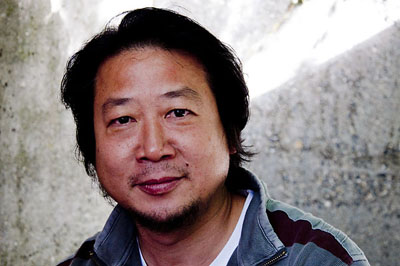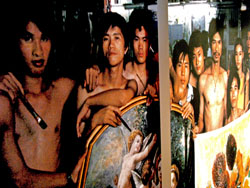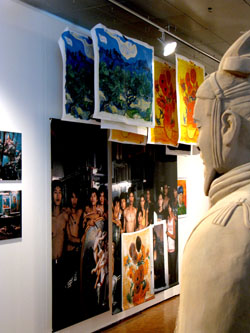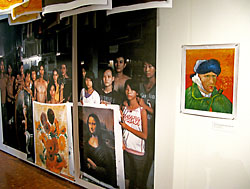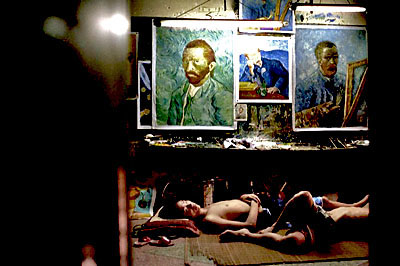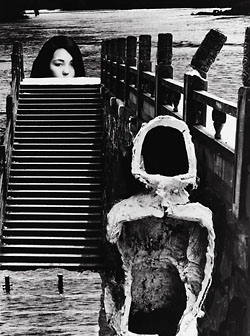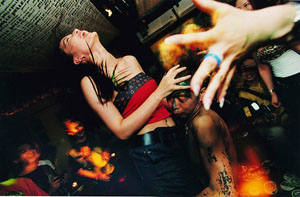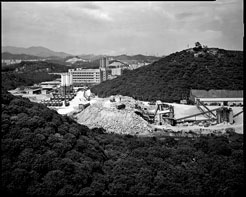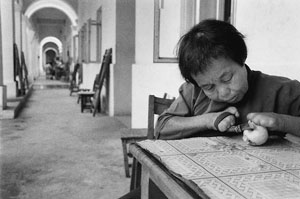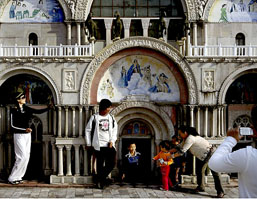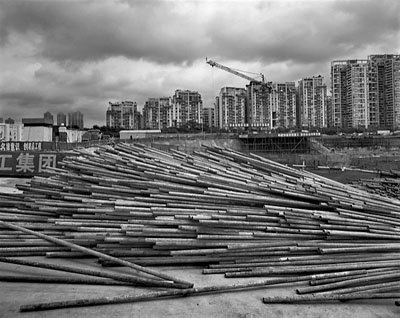|
|
|
Time is money--Efficiency is life
Yu
Haibo was in Switzerland for a few days in late May. His photographic
project Dafen Oil Painting Village was part of Die Kunst
des Verfälschens (The Art of Faking), an exhibition
presented at the Ethnographic Museum in Zürich, which
showed how China has copied, imitated and forged its own artifacts
throughout
all periods in history. Modern times are no exception. In 2005,
Yu Haibo embarked on the incredible story of documenting art
migrants who produce 60% of the world’s reproductions
of famous oil paintings.
industrialization.
Dafen is so dramatic in terms of size and humanity that Yu
Haibo felt that he needed to have
the artists themselves participate in his project. « Usually,
I take photos on the spot. I do not ask for any participation
and I do not create scenes, » Yu Haibo told me. « In
Dafen, I took photographs of people while they were painting,
eating or sleeping. These are natural moments. But, little by
little, I became interested in seeing how these artists were
looking at me or at my lens. I felt I needed to represent the
craftsmen’s gaze. All my other portfolios are spontaneous.
Here, there is a composition with people looking at the lens
in a moment of silence. »
Van
Gogh is very popular in the world’s households. On
the different websites that Dafen village has developped,
one can buy The Man with a Pipe for $40. The reproduction,
or should
we say one of the reproductions, was hanging on the wall
of the Ethnographic Museum of Zürich. The artist, Zhao
Qiyong, painted it in 2010. The original dates back to 1889.
A natural
question would be to ask which art school had trained Zhao
Qiyong. Even if the work was done quickly, and still smells
of fresh
paint, the technique is impressive. So, it is surprising
to learn that the artist never went to any art school. « Everybody
paints in his family. His younger brother, his wife, » explains
Yu Haibo. « They all paint Van Gogh because it is quick.
There is also an economic reason because many people like
Van Gogh. » The fastest workers in Dafen can paint
up to 30 paintings a day ! According to an article published
in
the German
magazine Der Spiegel in 2006, an artist in Dafen will make
between $128 and $385 a month. That makes quite a lot of
reproductions
a day at $0.45 per copy!
Born
in 1969 during the Cultural Revolution, Yu Haibo still remembers
the cultural uniformity of his childhood. When
Deng Xiaoping
opened China to the world, the society started to liberate
itself but still had enormous problems. Yu Haibo left his
native province
of Henan in 1987 to study photography at the university
of Wuhan, in the neighboring province of Hubei. As every art
student in
China does, Yu Haibo began by studying painting and drawing.
But he knew early on that photography would be his medium. « At
the beginning, it was a difficult choice, » notes Yu Haibo. « In
the 1980s, photographic material and equipment were difficult
to find in China and they were also very expensive. So,
it was technically difficult. But it was also intellectually
challenging
because people did not understand at that time why I wanted
to be a photographer and not a painter. »
Already
in 1988, Yu Haibo began showing his instinctive inclination
for surrealism. On
the Other Shore, a series of black and white photographs/collages,
allowed him to treat his frustrations and hopes in a more
abstract way. Yu Haibo felt a distance between himself
and traditional
Chinese painting. His resonance was more with the freedom
that a camera could give. He also found possibilities and
freedom
by reading western philosophy.
Yu
Haibo has an ethnographic approach to the city of Shenzhen. Breath
of Night is a portfolio that captures the thundering
energy of the city’s youth. China’s Urban Expansion narrates
the surgical effect on the landscape of the destruction
of farmlands.
The Last Days sensitively recounts the daily
life of leprosy patients. China’s Global Village shows
how Chinese tourists naïvely participate in a
conversation with the world. But, beyond the categorization,
Yu Haibo asks profound questions about
the definition of life. The people he meets are either
extremely rich or extremely poor. « What are
their dreams ? » the
photographer asks. « Rich people are more and
more busy with a materialistic dream. Shopping has
become one of their
favorite occupations. People want to live better. What
is in the psyche of people ? Life conditions between
rich and poor
are fundamentaly different but the search for happiness
and the realization of dreams are identical. » The
depiction of the individual story, of the individual
dream, is
what makes
a photograph and cements the portfolios together.
We are greatly indebted to Yu Haibo who came especially
to Geneva to share his vision about life and photography
with
us. |
All material copyright 2010 by 3 dots water

